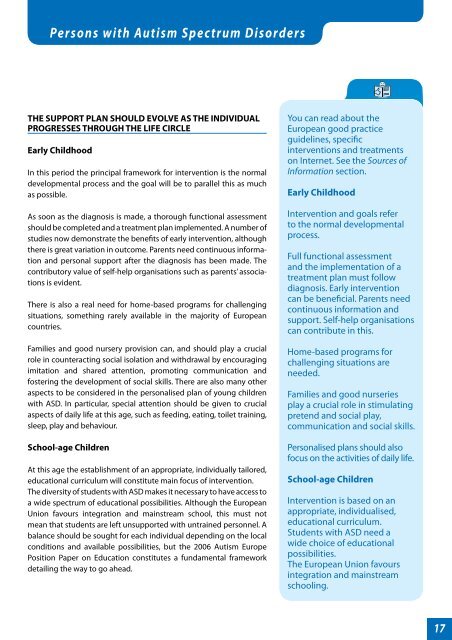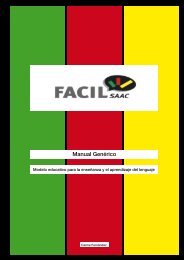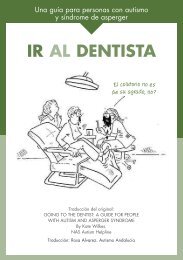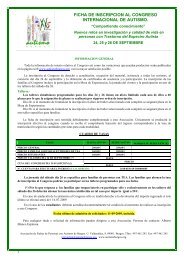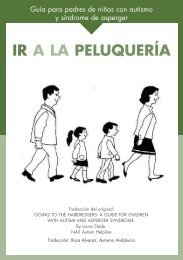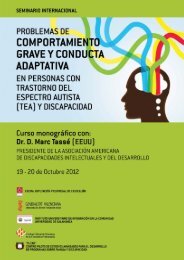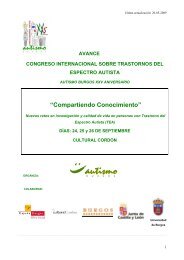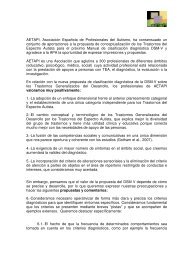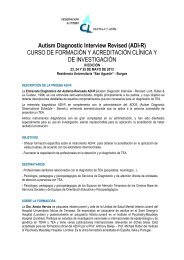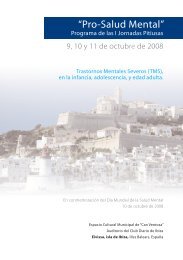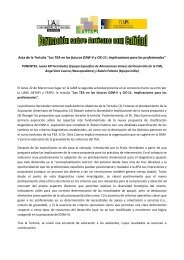persons with autism spectrum disorders - Aetapi
persons with autism spectrum disorders - Aetapi
persons with autism spectrum disorders - Aetapi
You also want an ePaper? Increase the reach of your titles
YUMPU automatically turns print PDFs into web optimized ePapers that Google loves.
Persons <strong>with</strong> Autism Spectrum Disorders<br />
THE SUPPORT PLAN SHOULD EVOLVE AS THE INDIVIDUAL<br />
PROGRESSES THROUGH THE LIFE CIRCLE<br />
Early Childhood<br />
In this period the principal framework for intervention is the normal<br />
developmental process and the goal will be to parallel this as much<br />
as possible.<br />
As soon as the diagnosis is made, a thorough functional assessment<br />
should be completed and a treatment plan implemented. A number of<br />
studies now demonstrate the benefits of early intervention, although<br />
there is great variation in outcome. Parents need continuous information<br />
and personal support after the diagnosis has been made. The<br />
contributory value of self-help organisations such as parents’ associations<br />
is evident.<br />
There is also a real need for home-based programs for challenging<br />
situations, something rarely available in the majority of European<br />
countries.<br />
Families and good nursery provision can, and should play a crucial<br />
role in counteracting social isolation and <strong>with</strong>drawal by encouraging<br />
imitation and shared attention, promoting communication and<br />
fostering the development of social skills. There are also many other<br />
aspects to be considered in the personalised plan of young children<br />
<strong>with</strong> ASD. In particular, special attention should be given to crucial<br />
aspects of daily life at this age, such as feeding, eating, toilet training,<br />
sleep, play and behaviour.<br />
School-age Children<br />
At this age the establishment of an appropriate, individually tailored,<br />
educational curriculum will constitute main focus of intervention.<br />
The diversity of students <strong>with</strong> ASD makes it necessary to have access to<br />
a wide <strong>spectrum</strong> of educational possibilities. Although the European<br />
Union favours integration and mainstream school, this must not<br />
mean that students are left unsupported <strong>with</strong> untrained personnel. A<br />
balance should be sought for each individual depending on the local<br />
conditions and available possibilities, but the 2006 Autism Europe<br />
Position Paper on Education constitutes a fundamental framework<br />
detailing the way to go ahead.<br />
You can read about the<br />
European good practice<br />
guidelines, specific<br />
interventions and treatments<br />
on Internet. See the Sources of<br />
Information section.<br />
Early Childhood<br />
Intervention and goals refer<br />
to the normal developmental<br />
process.<br />
Full functional assessment<br />
and the implementation of a<br />
treatment plan must follow<br />
diagnosis. Early intervention<br />
can be beneficial. Parents need<br />
continuous information and<br />
support. Self-help organisations<br />
can contribute in this.<br />
Home-based programs for<br />
challenging situations are<br />
needed.<br />
Families and good nurseries<br />
play a crucial role in stimulating<br />
pretend and social play,<br />
communication and social skills.<br />
Personalised plans should also<br />
focus on the activities of daily life.<br />
School-age Children<br />
Intervention is based on an<br />
appropriate, individualised,<br />
educational curriculum.<br />
Students <strong>with</strong> ASD need a<br />
wide choice of educational<br />
possibilities.<br />
The European Union favours<br />
integration and mainstream<br />
schooling.<br />
17


